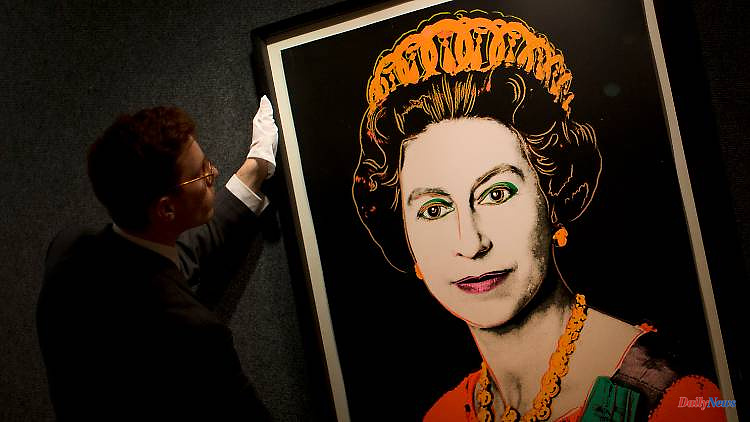Sung about by the Beatles, ridiculed by the Sex Pistols, painted by Andy Warhol and portrayed by Helen Mirren, the Queen has become a pop culture icon during her long tenure. And she has also shown her sense of humor in recent years.
When the Queen became Queen of the United Kingdom in 1952, James Bond had not yet been invented, Paul McCartney had not yet met John Lennon and Johnny Rotten, singer of the Sex Pistols, had not even been born. During her reign, Elizabeth II witnessed the end of the British Empire. But she also saw how Britain conquered the world in other ways: with films and books, with Beatlemania, the British Invasion and punk, with fashion and style.
Over time, the ruler herself became part of this pop culture. Not only because she repeatedly received prominent musicians and actors, from Marilyn Monroe to the Bond actors to the Spice Girls. But because in a certain sense it accompanied the emergence of pop - and became its motive.
Countless fashions, trends and hypes have bounced off the Queen over the decades. She remained true to herself and became a symbol of continuity in times of rapid change. The older she got, the more people could identify with her - simply because they didn't know any other head of state. The Queen became the projection screen for hymns of praise, but also for harsh criticism in the popular arts.
She owes this omnipresence to another fact: the Queen was in the public eye from her earliest youth. Even as a little girl, she was a topic in the tabloid press, and at the age of three she graced the cover of "Time" magazine for the first time. She was constantly photographed and filmed, and is probably the most portrayed woman in history - right up to Andy Warhol, who published his portrait in many colors in a series of screenprints, of which the Queen bought a few copies in 2012.
"Her Majesty's a pretty nice girl, but she doesn't have a lot to say," Paul McCartney once sang on "Abbey Road." That sounded more teasing than critical. For the 50th anniversary of the throne in 2002, McCartney sang the song again, this time in the presence of the Queen, and it was more embarrassed than confident. Because the image of the queen had changed in the meantime. She had gone from being a ridiculed, young monarch with no political power to a world-famous figure, the personification of British understatement.
The Queen used this image. For decades, James Bond has acted on Her Majesty's behalf - from Scotsman Sean Connery to Englishman Daniel Craig. But Craig was the first to receive a special honor: At the opening of the London Olympics in 2012, as Bond, he escorted his chief lady of service to the stadium by helicopter and provided one of Elizabeth II's most spectacular and funniest performances - enthusiastically cheered by the people in the stadium.
Of course, that wasn't always the case: in 1977, the Sex Pistols spit out their "God Save the Queen" and rhymed it with "fascist regime". Punk's criticism of the establishment was harsh, the Brits were shocked - or bought the single and took it to number two on the charts. Elsewhere, too, people treated her with disrespect. In "Willi and the Windzors" by Hape Kerkeling, for example, the royal family has to leave Great Britain and ends up in a terraced housing estate in Hanover. Also unforgettable is the scene in which the Canadian Leslie Nielsen ends up between the Queen's legs in "The Naked Gun" after he had turned a state reception into chaos.
In the film, the compromising photo ends up on the front pages of the press. In reality, tabloid journalists in particular never held back with criticism of the Queen in Buckingham Palace. No wonder, given the many family scandals Elizabeth went through with her children in the '90s. The rejection of the Royals reached its peak in 1997 with the death of Princess Diana, the "Princess of Hearts". Her mother-in-law's muted reaction drew sharp criticism. It was the time when the British puppet show "Spitting Image" badmouthed the royal family.
Ironically, a film about this time, "The Queen" by Stephen Frears, was years later an expression of the change in public perception: There was understanding for the Queen, for her role as head of state, for her discipline in deep crises. Also thanks to Helen Mirren's balanced portrayal, who had studied the Queen's facial expressions and gestures for months in preparation and was awarded the British Film Prize and Oscar for it. Since then, Elizabeth's life has been fictionally explored, from The King's Speech about her father to the series The Crown, which follows Elizabeth from her accession to the present day.
In the last years of her reign, the Queen had become an untouchable person. Even their fads were lovingly celebrated, becoming almost a part of British culture: from the love of corgis to the use of Tupperware in the royal household. Her wholly human likes and habits were forgiven in a woman who had lived her life in the service of her country, persistently and unflinchingly, always putting her own interests and opinions aside.
There were enough examples. Reports of the Queen enjoying playing with a Wii were greeted with enthusiasm, as was US President Barack Obama's gift of an iPod, or the delightful photo bomb the Queen landed by accident. The Queen as a globally celebrated Internet meme, a 90-year-old as an influencer in the digital age. Her visit to the set of the hit series "Game of Thrones" also matched this. In one picture she looks almost pityingly at the eponymous Iron Throne of Swords - what was this myth-laden TV series compared to her own myth?
She had been laughed at and insulted, but in the new millennium Elizabeth II became the cool queen. So cool she appeared on The Simpsons. Their colorful costumes, along with matching hats and pearl necklaces, were no longer considered old-fashioned, but rather a constant sense of style. Her insistence on protocol, her countless appearances and patronages were no longer a sign of outdated monarchical thinking, but of discipline - and that she was "not amused" became a dictum. Her portraits on stamps and coins - actually signs of the greatest possible distance - were supplemented by official portraits, which, despite all the staging, also allowed for intimacy.
She not only showed her sense of humor when she appeared with James Bond at the Olympics. This year, on the 70th anniversary of her accession to the throne, she caused enthusiasm with a lovingly funny video: The Queen is sitting with Paddington the bear at tea, keeping her composure in the face of his clumsiness – and showing the jam sandwich in her handbag . This is British humor at its finest.
The ridiculed young queen and the sharply criticized representative of the British establishment had become a beloved, unifying figure. With Elizabeth II, the world is probably losing the last person who not only witnessed the fundamental change since the end of the Second World War, but also helped shape it - politically powerless, but symbolically influential. It is difficult to conceptualize this time because of the many developments. But just as her predecessors Elizabeth I and Victoria stand for epochs, Elizabeth II also symbolizes a culture: the age of pop.












